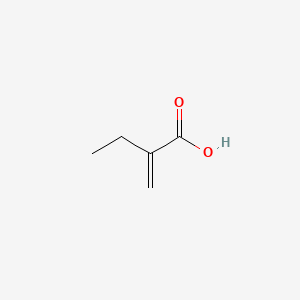| MeSH term | MeSH ID | Detail |
|---|---|---|
| Carcinoma, Basal Cell | D002280 | 6 associated lipids |
| Arrhythmias, Cardiac | D001145 | 42 associated lipids |
| Adenocarcinoma | D000230 | 166 associated lipids |
| Dermatitis, Contact | D003877 | 59 associated lipids |
| Dermatitis, Occupational | D009783 | 12 associated lipids |
| Lung Neoplasms | D008175 | 171 associated lipids |
| Body Weight | D001835 | 333 associated lipids |
| Edema | D004487 | 152 associated lipids |
| Bone Resorption | D001862 | 7 associated lipids |
| Brain Injuries | D001930 | 4 associated lipids |
2-Ethylacrylic acid
2-Ethylacrylic acid is a lipid of Fatty Acyls (FA) class. The involved functions are known as hemolysis.
Cross Reference
Introduction
To understand associated biological information of 2-Ethylacrylic acid, we collected biological information of abnormalities, associated pathways, cellular/molecular locations, biological functions, related genes/proteins, lipids and common seen animal/experimental models with organized paragraphs from literatures.
What diseases are associated with 2-Ethylacrylic acid?
There are no associated biomedical information in the current reference collection.
Possible diseases from mapped MeSH terms on references
We collected disease MeSH terms mapped to the references associated with 2-Ethylacrylic acid
PubChem Associated disorders and diseases
What pathways are associated with 2-Ethylacrylic acid
There are no associated biomedical information in the current reference collection.
PubChem Biomolecular Interactions and Pathways
Link to PubChem Biomolecular Interactions and PathwaysWhat cellular locations are associated with 2-Ethylacrylic acid?
There are no associated biomedical information in the current reference collection.
What functions are associated with 2-Ethylacrylic acid?
Related references are published most in these journals:
| Function | Cross reference | Weighted score | Related literatures |
|---|
What lipids are associated with 2-Ethylacrylic acid?
There are no associated biomedical information in the current reference collection.
What genes are associated with 2-Ethylacrylic acid?
There are no associated biomedical information in the current reference collection.
What common seen animal models are associated with 2-Ethylacrylic acid?
There are no associated biomedical information in the current reference collection.
NCBI Entrez Crosslinks
All references with 2-Ethylacrylic acid
Download all related citations| Authors | Title | Published | Journal | PubMed Link |
|---|---|---|---|---|
| RodrÃguez Hernández JC et al. | Fibrinogen patterns and activity on substrates with tailored hydroxy density. | 2009 | Macromol Biosci | pmid:19422014 |
| Peljhan S et al. | Strong intermolecular association between short poly(ethacrylic acid) chains in aqueous solutions. | 2009 | J Phys Chem B | pmid:19193057 |
| Krizanic F et al. | Transvenous closure of patent foramen ovale: preliminary results with a new self-expanding nitinol wire mesh in a Swine model. | 2009 | Cardiol Res Pract | pmid:19946631 |
| Negreiros WA et al. | Effect of flask closure method and post-pressing time on the displacement of maxillary denture teeth. | 2009 | Open Dent J | pmid:19444339 |
| Consani RL et al. | Effect of repeated simulated disinfections by microwave energy on the complete denture base adaptation. | 2008 | Open Dent J | pmid:19088884 |
| Cilurzo F et al. | Design and characterization of an adhesive matrix based on a poly(ethyl acrylate, methyl methacrylate). | 2008 | AAPS PharmSciTech | pmid:18563579 |
| Ishii T et al. | Comparative evaluation of thione and phosphate monomers on bonding gold alloy and Ti-6Al-7Nb alloy with tri-n-butylborane initiated resin. | 2008 | Dent Mater J | pmid:18309612 |
| Gahlert M et al. | Biomechanical and histomorphometric comparison between zirconia implants with varying surface textures and a titanium implant in the maxilla of miniature pigs. | 2007 | Clin Oral Implants Res | pmid:17608736 |
| Le Diagon Y et al. | Particle structuring under the effect of an uniaxial deformation in soft/hard nanocomposites. | 2007 | Eur Phys J E Soft Matter | pmid:17334689 |
| BrÃgido Diego R et al. | Effect of gamma-irradiation on the structure of poly(ethyl acrylate-co-hydroxyethyl methacrylate) copolymer networks for biomedical applications. | 2007 | J Mater Sci Mater Med | pmid:17136603 |
| Murthy SK | Nanoparticles in modern medicine: state of the art and future challenges. | 2007 | Int J Nanomedicine | pmid:17722542 |
| Adibkia K et al. | Inhibition of endotoxin-induced uveitis by methylprednisolone acetate nanosuspension in rabbits. | 2007 | J Ocul Pharmacol Ther | pmid:17900230 |
| Attygalle AB et al. | Biosynthesis of tiglic, ethacrylic, and 2-methylbutyric acids in a carabid beetle, Pterostichus (Hypherpes) californicus. | 2007 | J. Chem. Ecol. | pmid:17404818 |
| Gonçalves TS et al. | Allergy to auto-polymerized acrylic resin in an orthodontic patient. | 2006 | Am J Orthod Dentofacial Orthop | pmid:16527642 |
| Jérôme C et al. | Surface modification of metallic cardiovascular stents by strongly adhering aliphatic polyester coatings. | 2006 | J Biomed Mater Res A | pmid:16317721 |
| Murata H et al. | An alcohol-free tissue conditioner--a laboratory evaluation. | 2006 | J Dent | pmid:16216404 |
| Liu YY et al. | Preparation, properties and controlled release behaviors of pH-induced thermosensitive amphiphilic gels. | 2006 | Biomaterials | pmid:16563494 |
| Peregrina A et al. | The effect of different adhesives on vinyl polysiloxane bond strength to two tray materials. | 2005 | J Prosthet Dent | pmid:16126072 |
| Li Z et al. | Analysis of liquid-phase chemical detection using guided shear horizontal-surface acoustic wave sensors. | 2005 | Anal. Chem. | pmid:16013878 |
| Alava JI et al. | Effects of bacterial adhesion with respect to the type of material, structure and design of intraocular lenses. | 2005 | J Mater Sci Mater Med | pmid:15803275 |
